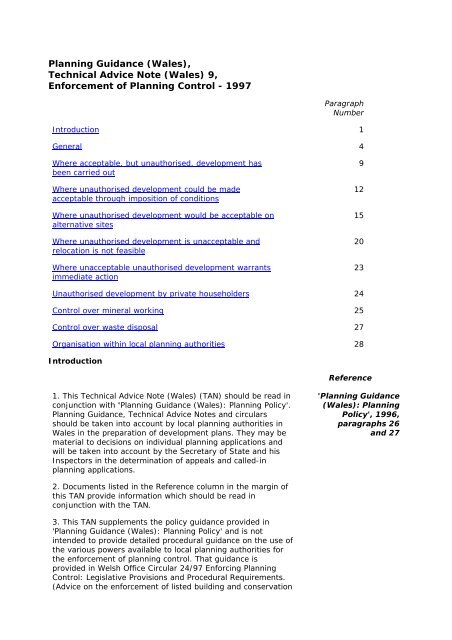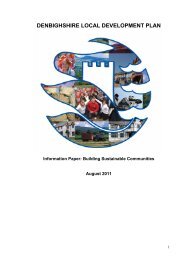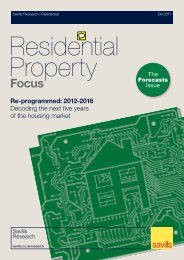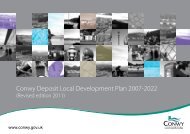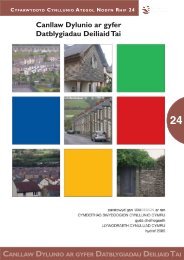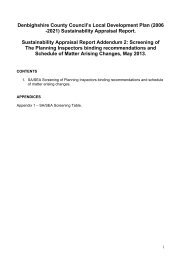TAN 9: Enforcement of Planning Control
TAN 9: Enforcement of Planning Control
TAN 9: Enforcement of Planning Control
You also want an ePaper? Increase the reach of your titles
YUMPU automatically turns print PDFs into web optimized ePapers that Google loves.
<strong>Planning</strong> Guidance (Wales),Technical Advice Note (Wales) 9,<strong>Enforcement</strong> <strong>of</strong> <strong>Planning</strong> <strong>Control</strong> - 1997ParagraphNumberIntroduction 1General 4Where acceptable, but unauthorised, development hasbeen carried outWhere unauthorised development could be madeacceptable through imposition <strong>of</strong> conditionsWhere unauthorised development would be acceptable onalternative sitesWhere unauthorised development is unacceptable andrelocation is not feasibleWhere unacceptable unauthorised development warrantsimmediate action912152023Unauthorised development by private householders 24<strong>Control</strong> over mineral working 25<strong>Control</strong> over waste disposal 27Organisation within local planning authorities 28IntroductionReference1. This Technical Advice Note (Wales) (<strong>TAN</strong>) should be read inconjunction with '<strong>Planning</strong> Guidance (Wales): <strong>Planning</strong> Policy'.<strong>Planning</strong> Guidance, Technical Advice Notes and circularsshould be taken into account by local planning authorities inWales in the preparation <strong>of</strong> development plans. They may bematerial to decisions on individual planning applications andwill be taken into account by the Secretary <strong>of</strong> State and hisInspectors in the determination <strong>of</strong> appeals and called-inplanning applications.'<strong>Planning</strong> Guidance(Wales): <strong>Planning</strong>Policy', 1996,paragraphs 26and 272. Documents listed in the Reference column in the margin <strong>of</strong>this <strong>TAN</strong> provide information which should be read inconjunction with the <strong>TAN</strong>.3. This <strong>TAN</strong> supplements the policy guidance provided in'<strong>Planning</strong> Guidance (Wales): <strong>Planning</strong> Policy' and is notintended to provide detailed procedural guidance on the use <strong>of</strong>the various powers available to local planning authorities forthe enforcement <strong>of</strong> planning control. That guidance isprovided in Welsh Office Circular 24/97 Enforcing <strong>Planning</strong><strong>Control</strong>: Legislative Provisions and Procedural Requirements.(Advice on the enforcement <strong>of</strong> listed building and conservation
area controls is provided in Welsh Office Circular 61/96<strong>Planning</strong> and the Historic Environment: Historic Buildings andConservation Areas).General4. The town and country planning system regulates thedevelopment and use <strong>of</strong> land in the public interest.Responsibility for determining whether proposed developmentshould be granted planning permission rests initially with thelocal planning authority; as does the decision on whetherunauthorised development (development carried out withoutthe necessary planning permission or development carried outin contravention <strong>of</strong> a condition or limitation attached to aplanning permission) should be allowed to continue or shouldbe enforced against. A private citizen cannot initiateenforcement action, but may advise the local planningauthority <strong>of</strong> a breach <strong>of</strong> planning control he or she maybelieve has occurred.Top <strong>of</strong> Page5. Although it is not a criminal <strong>of</strong>fence to carry outdevelopment without first obtaining any necessary planningpermission, such action is to be discouraged. The fact thatenforcement action is discretionary and should be used as alast resort and only when it is expedient, should not be takenas condoning the wilful breach <strong>of</strong> planning controls. Powersare available to local planning authorities to bringunauthorised development under planning control, and it is forthem to decide which power, or combination <strong>of</strong> powers, touse.6. In considering enforcement action, the decisive issue forthe local planning authority should be whether the breach <strong>of</strong>planning control would unacceptably affect public amenity orthe existing use <strong>of</strong> land and buildings meriting protection inthe public interest. <strong>Enforcement</strong> action should becommensurate with the breach <strong>of</strong> planning control to which itrelates; it is usually inappropriate to take formal enforcementaction against a trivial or technical breach <strong>of</strong> control whichcauses no harm to public amenity. The intention should be toremedy the effects <strong>of</strong> the breach <strong>of</strong> planning control, not topunish the person(s) carrying out the breach. Nor shouldenforcement action be taken simply to regularise developmentfor which permission had not been sought, but which isotherwise acceptable.7. Before any person, or persons, carry out development <strong>of</strong>land, it is advisable that they should discuss with the localplanning authority whether, in the authority's opinion,planning permission would be necessary for the developmentproposed. Some breaches <strong>of</strong> planning control are deliberatebut, in some cases, unauthorised development has beencarried out in good faith because the developer believed thatplanning permission was not needed. While that latter factor isnot relevant in determining whether or not to takeenforcement action, the cost to the developer <strong>of</strong> responding toenforcement action may represent a substantial financial
urden and this should be taken into account by the localplanning authority when deciding how to handle a particularcase. It should not, however, prevent action being taken whenit is clearly necessary to do so.Top <strong>of</strong> Page8. The initial aim should be to explore, in discussion with theowner or occupier <strong>of</strong> the land, what steps, if any, could betaken to reduce any adverse effects on public amenity to anacceptable level. However, local planning authorities shouldbear in mind the statutory time limits for taking enforcementaction and that prompt initiation <strong>of</strong> enforcement action maybe necessary to prevent an unacceptable breach <strong>of</strong> planningcontrol from becoming well established and more difficult toremedy.Where acceptable, but unauthorised, development hasbeen carried out9. Where the local planning authority's assessment is that it islikely that unconditional planning permission would be grantedfor development which has already taken place, the correctapproach is to suggest to the person responsible for theunauthorised development that they should promptly submit aretrospective application for planning permission.10. In such circumstances, it should be pointed out to theowner or occupier that if, for instance, they subsequently wishto dispose <strong>of</strong> their interest in the land and have no evidence <strong>of</strong>any permission having been granted for its development, thismay be reflected in the valuation and give rise to uncertaintyabout the rights they have over the land.11. It will generally be regarded as unreasonable for a localplanning authority to issue an enforcement notice solely toremedy the absence <strong>of</strong> a valid planning permission. If, onappeal to the Secretary <strong>of</strong> State, it is concluded that there isno significant planning objection to the breach <strong>of</strong> planningcontrol as alleged in the enforcement notice, such action by alocal planning authority could result in an award <strong>of</strong> costs beingmade against it.Welsh OfficeCircular 23/93Awards <strong>of</strong> Costsincurred in<strong>Planning</strong> andOther (includingCompulsoryPurchase Order)ProceedingsTop <strong>of</strong> PageWhere unauthorised development could be madeacceptable through imposition <strong>of</strong> conditions12. Where a local planning authority considers that anunauthorised development could be made acceptable by theimposition <strong>of</strong> planning conditions it should invite the owner oroccupier <strong>of</strong> the land to submit an application for planningpermission. It should be made clear to the person concernedthat the local planning authority does not wish thedevelopment to cease, but that it has a public duty tosafeguard amenity by ensuring that development is carriedout, or continued, within acceptable limits, having regard to
local circumstances and relevant planning policies.13. If, after a formal invitation to do so, the owner or occupier<strong>of</strong> the land refuses to submit a planning application whichwould enable the local planning authority to grant conditionalplanning permission, the local planning authority would bejustified in issuing an enforcement notice if, in its view, theunauthorised development has resulted in any unacceptableinjury to public amenity, or damage to a statutorily designatedsite, which can only be satisfactorily removed or alleviated byimposing conditions on a grant <strong>of</strong> planning permission for thedevelopment.14. When an enforcement notice is issued to enable the localplanning authority to grant conditional planning permission, itshould explain clearly in its statement <strong>of</strong> reasons for issuingthe notice, what unacceptable injury to public amenity, ordamage to the site, has been caused by the unauthoriseddevelopment and how the conditional grant <strong>of</strong> permission willeffectively remedy it. The owner or occupier will then have nodoubt about the purpose <strong>of</strong> the enforcement action, or whatthey are required to do in order to remove or alleviate theperceived injury to public amenity.Top <strong>of</strong> PageWhere unauthorised development would be acceptableon alternative sites15. It is not the local planning authority's responsibility, nor arequirement on it under the enforcement provisions, toidentify, or provide, alternative sites to which unauthoriseddevelopment might be relocated. Nevertheless, if, as part <strong>of</strong>its economic development functions, the authority is aware <strong>of</strong>an alternative site, it will usually be helpful to suggest it andto encourage the removal <strong>of</strong> the unauthorised development toit.16. If an alternative site has been suggested, it should bemade clear that the local planning authority expects theunauthorised development to relocate to that alternative site,or some other site acceptable to the local planning authority.The local planning authority should set a reasonable time limitwithin which relocation should be completed. What isreasonable will depend on the particular circumstances,including the nature and extent <strong>of</strong> the unauthoriseddevelopment; the time needed to negotiate for, and secure aninterest in the relocation site; and the need to avoidunacceptable disruption during the relocation process.17. Where an agreed timetable for relocation is ignored, it willusually be expedient for the local planning authority to issuean enforcement notice. In that event, the period forcompliance with the requirements <strong>of</strong> the enforcement noticeshould reflect what the local planning authority regards as areasonable period to complete the relocation.18. Where a small business or self-employed person isinvolved, the local planning authority should be aware <strong>of</strong> theneed to minimise disruption to the business and, if possible,
avoid any permanent loss <strong>of</strong> employment as a result <strong>of</strong> therelocation. Local planning authorities should also bear in mindthat, once an enforcement notice has taken effect, they havethe power to withdraw the notice or to waive or relax anyrequirement in it, including the period for compliance. Areasonable period for compliance, or an extension <strong>of</strong> the initialperiod, may make the difference between enabling a smallbusiness or self-employed person to continue operating, orcompelling them to cease trading.19. The Government remains committed to fostering businessenterprise, provided that the necessary development can takeplace without unacceptable harm to public amenity. Localplanning authorities should bear this in mind when consideringhow best to deal with unauthorised development by smallbusinesses. Nevertheless, effective enforcement action islikely to be the only appropriate remedy if the businessactivity is causing unacceptable harm.Where unauthorised development is unacceptable andrelocation is not feasible20. Where the local planning authority considers unacceptableunauthorised development has been carried out, and there isno realistic prospect <strong>of</strong> its being relocated to a more suitablesite - either because such a site is not available or the owneror occupier refuses to relocate - the owner or occupier <strong>of</strong> theland should be informed that the local planning authority isnot prepared to allow the operation or activity to continue atits present level <strong>of</strong> activity or, if that is the case, at all.21. If the unauthorised development provides valued localemployment, the owner or occupier should be advised <strong>of</strong> thelength <strong>of</strong> time the local planning authority is prepared to waitbefore the operation or activity must stop. If agreement canbe reached between the operator and the local planningauthority about this period and the agreement is honoured,formal enforcement action may be avoided.Top <strong>of</strong> Page22. Local planning authorities should bear in mind thepossibility <strong>of</strong> intensification <strong>of</strong> the development amounting toa material change <strong>of</strong> use after the expiry <strong>of</strong> the statutoryperiod for taking enforcement action. If no agreement can bereached, the issue <strong>of</strong> an enforcement notice will usually bejustified, allowing a realistic period for the unauthorisedoperation or activity to cease or its scale to be reduced to anacceptable level. Any difficulty with relocation will notnormally be a sufficient reason for delaying formalenforcement action to remedy unacceptable unauthoriseddevelopment.Where unacceptable unauthorised developmentwarrants immediate action23. Where a local planning authority considers that anunauthorised development is causing unacceptable harm topublic amenity, and there is little likelihood <strong>of</strong> the matterbeing resolved through negotiations or voluntarily, they
should take vigorous enforcement action to remedy thebreach urgently, or prevent further serious harm to publicamenity.Unauthorised development by private householders24. Where the householder appears to have relied onpermitted development rights as authorisation for thedevelopment, but a specified limitation has been exceeded incarrying it out, in considering whether it is expedient to takeenforcement action, the local planning authority should havefull regard to what would have been permitted if thedevelopment had been carried out in strict accordance withthe relevant provisions. Local planning authorities should notnormally take enforcement action in order to remedy only aslight variation in excess <strong>of</strong> what would have been permittedby virtue <strong>of</strong> the GPDO provisions.The Town andCountry <strong>Planning</strong>(General PermittedDevelopment)Order 1995(SI No 1995/418)<strong>Control</strong> over mineral working25. Mineral planning control is well established as part <strong>of</strong> thegeneral planning system and there are no separateenforcement powers for unauthorised mineral working. Thegeneral policies and principles applicable to enforcement applyequally to mineral cases.Top <strong>of</strong> Page26. Unauthorised mineral working sometimes poses particularenforcement problems, both in terms <strong>of</strong> the occasionallyirremediable nature <strong>of</strong> the working and the speed at whichdamage can be caused as well as the fact that they will haveno arrangements for restoration and aftercare <strong>of</strong> the land oreven an agreed after use. (Care also needs to be taken toensure that, with authorised works, restoration and aftercareis carried out fully in accordance with the terms <strong>of</strong> the agreedschemes.) While the powers available to local planningauthorities are helpful in preventing damage which wouldotherwise be virtually or totally irremediable, either to the siteitself or to its surroundings (and those powers would enableenforcement action to be taken quickly should the need arise),it is clearly preferable for there to be effective liaison andcontacts between local planning authorities and mineralsoperators, which would avoid contraventions <strong>of</strong> planningconditions and enable any problems to be resolved throughdiscussion and co-operation.<strong>Control</strong> over waste disposal27. The advice in paragraph 26 above applies equally to wastedisposal and landfill sites.Organisation within local planning authorities28. It is for each local planning authority to decide how toorganise the enforcement <strong>of</strong> planning control in its area. Theorganisation should correspond to the volume and complexity<strong>of</strong> enforcement casework in each local planning authority areaand be sufficiently flexible to adapt to any short termincreases in the demand for enforcement. All authorities
should ensure that there is a close and co-operative workingrelationship between the <strong>Planning</strong> and Legal departments andother departments e.g. building control and environmentalhealth. Although those other departments may be concernedwith the enforcement <strong>of</strong> controls outside the planning regime,they could have information which could be relevant to theidentification <strong>of</strong> possible, or actual, contraventions <strong>of</strong> planningcontrol.29. Without such effective working relationships, formalenforcement action (which depends for its success upon speed<strong>of</strong> assessment and process) may be hampered by poorcommunications and misunderstandings. Public criticism isthen likely, especially if statutory time limits for takingenforcement action are allowed to expire because <strong>of</strong>administrative delay. All local planning authorities shouldregularly review the effectiveness <strong>of</strong> their proceduralarrangements for planning enforcement; and, wherenecessary, introduce revised arrangements.30. When complaints about alleged breaches <strong>of</strong> planningcontrol are received, they should always be properly recordedand investigated. The Commissioner for Local Administrationhas held, in a number <strong>of</strong> cases, that there had beenmaladministration where the local planning authority hadfailed to take effective enforcement action which was plainlynecessary, and has occasionally recommended acompensatory payment to the complainant for the consequentinjustice. While this does not mean that enforcement actionshould be taken automatically following a complaint, if thelocal planning authority decide to exercise its discretion not totake enforcement action where a complaint is made, it shouldbe prepared to explain its reasons to any organisation orperson who has asked for an alleged breach <strong>of</strong> planningcontrol to be investigated.Source Division: <strong>Planning</strong>Date: July 2000


